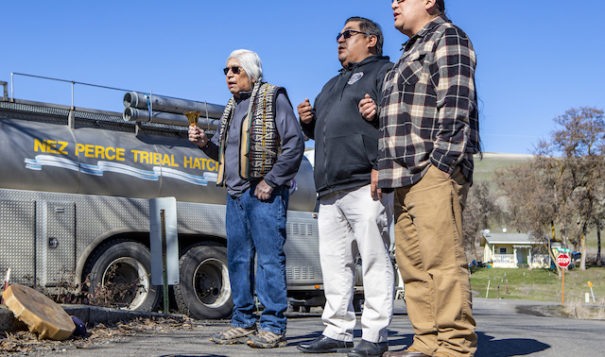News Based on facts, either observed and verified directly by the reporter, or reported and verified from knowledgeable sources.
Juvenile spring chinook brought back to creeks on Nez Perce Reservation
 Nez Perce tribal elder Charles Axtell (left), NPTEC Vice-Chairman Shannon Wheeler and NPTEC Treasurer Casey Mitchell sing ceremonially on Wednesday before releasing thousands of juvenile spring chinook into Sweetwater Creek near Webb.
Nez Perce tribal elder Charles Axtell (left), NPTEC Vice-Chairman Shannon Wheeler and NPTEC Treasurer Casey Mitchell sing ceremonially on Wednesday before releasing thousands of juvenile spring chinook into Sweetwater Creek near Webb.
Juvenile spring chinook are swimming in Sweetwater and Lapwai creeks on the Nez Perce Reservation for the first time in nearly a century.
Soon the young fish, released by the Nez Perce Tribe on March 9, will begin their migration to the Pacific Ocean and within two years some of them can be expected to return as adults and provide fishing opportunity to tribal and nontribal anglers, broodstock for future hatchery production and some natural spawning as well.
The roughly 200,000 smolts were produced at Dworshak National Fish Hatchery and raised at the Nez Perce Tribal Hatchery under the Lower Snake River Mitigation program that was established to replace salmon killed by the four federal dams between Lewiston and the Tri-Cities. The release was made possible by years of cooperative work between the tribe, the Lewiston Orchards Irrigation District and the U.S. Bureau of Reclamation that has turned Sweetwater Creek in particular into a more hospitable environment for fish.
Since its inception in the early 1900s, the irrigation district has tapped the headwaters of Webb, Sweetwater and other creeks on Craig Mountain south of Lewiston and delivered water used to irrigate pastures, orchards and now mostly lawns in the Lewiston Orchards.
But it also meant the creeks, home to Endangered Species Act protected fish like steelhead, ran low and hot in the summer months.
In 2010, the tribe sued multiple federal agencies seeking to return water to the creeks. Negotiations between the parties and other stakeholders yielded a settlement centered on drilling a series of deep aquifer wells in the Orchards. Each time a new well comes online, an amount of water equal to its output is allowed to stay in the creeks.
David Johnson, director of the tribe’s Department of Fisheries Resources Management, said the exchange increased flows in Sweetwater Creek from a range of 0 to 3.5 cubic feet per second in summer months to a range of 3.5 cfs to 12.5 cfs. The tribe has also worked to improve habitat through various rehabilitation projects such as reconnecting the creek to its floodplain and planting vegetation along its banks.
The water provides better habitat for threatened steelhead and the opportunity for the reestablishment of spring chinook.
“Sweetwater Creek has been an important area for the tribe for generations because it’s a cooler source of water because of its origins up there on Waha Lake,” Johnson said.
Spring chinook were extirpated from the Clearwater Basin with the construction of the Lewiston Dam in 1927. When the dam was removed in the 1970s, a hatchery spring chinook program was established in the basin.
The juvenile chinook have had their adipose fins removed, said Scott Keller, manager of the Nez Perce Tribal Hatchery. The fin removal identifies them as being of hatchery origin and available for harvest when they return as adults.
Johnson said tribal fisheries workers will be able to collect fish for hatchery spawning at a weir near the mouth of Lapwai Creek and tribal members will be able to fish for spring chinook in Lapwai and Sweetwater Creeks.
“We want to make sure we get the brood but we are looking forward to have an opportunity to fish right here in the heart of the reservation,” he said.
The fish will also be available to nontribal anglers as they pass through the lower Clearwater River.
Chinook that escape the fishery will be able to spawn in the creeks.
Barker may be contacted at ebarker@lmtribune.com or at (208) 848-2273. Follow him on Twitter @ezebarker.
